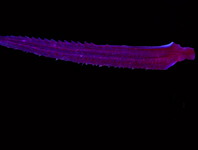Abstract
Due to the highly conserved morphology of its members, the taxonomy of Pareas remains contentious. Microornamentation was examined on the exposed surfaces of dorsal scales from the midbody region of five species of genus Pareas. The results showed that the ultrastructural characteristics are similar in some respects and different in others. Similarly, all species exhibit arc and pore structures, but the shape, number and arrangement of these arcs and pores differ. In particular, the microornamentation of the dorsal scales of Pareas yunnanensis, thus far regarded as a synonym of P. chinensis, is obviously different from that of P. chinensis. Thus, P. yunnanensis is revalidated. The ultrastructural characteristics of these five species of Pareas are very different from those of reported for P. carinatus. P. carinatus may not belong to the same genus as other Pareas species.
References
Chiasson, R.B. & Lowe, C.H. (1989) Ultrastructural scale patterns in Nerodia and Thamnophis. Journal of Herpetology, 23, 109–118.
https://doi.org/10.2307/1564016
Dowling, H.G. & Price R.M. (1988) A proposed new genus for Elaphe subocularis and Elaphe rosaliae. The Snake, 20, 52–63.
Gower, D. (2003) Scale microornamentation of uropeltid snakes. Journal of Morphology, 258, 249–268.
https://doi.org/10.1002/jmor.10147
Guo, K.J. & Deng, X.J. (2009) A new species of Pareas (Serpentes: Colubridae: Pareatinae) from the Gaoligong Mountains, southwestern China. Zootaxa, 2008, 53–60.
Guo, Y.H., Wu, Y.K., He, S.P., Shi, H.T. & Zhao, E.M. (2011) Systematics and molecular of Asian snail-eating snakes (Pareatidae). Zootaxa, 3001 (1), 57–64.
https://doi.org/10.11646/zootaxa.3001.1.4
Hauser, S. (2017) On the validity of Pareas macularius Theobald, 1868 (Squamata: Pareidae) as a species distinct from Pareas margaritophorus (Jan in Bocourt, 1866). Tropical Natural History, 17 (1), 25–52.
He, M. (2009) Phylogeny of Colubridae based on molecular and scale microornamentation data, with an emphasis on hot spring keel-backs (Thermophis). Ph.D. thesis, Sichuan University, Chengdu. [pagination unknown, in Chinese]
Price, R.M. (1982) Dorsal snake scale microdermatoglyphics: ecological indicator or taxonomic tool? Journal of Herpetology, 16, 294–306.
https://doi.org/10.2307/1563721
Price, R.M. (1987) Microdermatoglyphics: suggested taxonomic affinities of the viperid genera Azemiops and Pseudocerastes. The Snake, 19, 47–50.
Rao, D.Q. & Yang, D.T. (1992) Phylogenetic systematics of Pareatinae (Serpentes) of Southeastern Asia and adjacent islands with relationship between it and the geology changes. Acta Zoologica Sinica, 38, 139–150. [in Chinese]
Vogel, G.A. (2015) New Montane species of the genus Pareas Wagler, 1830 (Squamata: Pareatidae) from Northern Myanmar. Taprobanica Private Limited, 7 (1), 1–7.
https://doi.org/10.4038/tapro.v7i1.7501
You, C.W., Poyarkov, Jr.N.A. & Lin, S.M. (2015) Diversity of the snail-eating snakes Pareas (Serpentes, Pareatidae) from Taiwan. Zoologica Scripta, 44 (4), 349–361.
https://doi.org/10.1111/zsc.12111
Zhao, E.M., Huang, M.H. & Zong, Y. (1998) Fauna Sinica Reptilia. Vol. 3. Squamata: Serpentes. Science Press, Beijing, 522 pp. [in Chinese]

